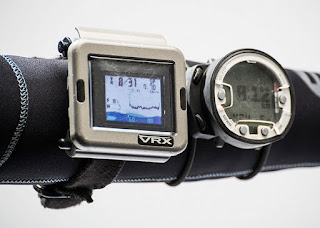Modern digital dive computers date to the early 80s, though
analog devices simulating tissue gas uptake and elimination through porous
membranes date back to the 70s. Analog devices were limited to nonstop divingand had a short shelf life.
Digital dive computers proved highly successful and
very useful right from the start, progressing from just table emulators to full
up algorithmic staging devices across mixed gas, open circuit (OC), rebreather
(RB), nonstop, decompression, deep, and shallow diving. Dive computers aremoderately expensive items these days, and high end units range beyond $1500.Basically, a decompression computer is a microprocessor consisting of a powersource, pressure transducer, analog to digital signal converter, internal
clock, chip with RAM (random access memory) and ROM (read only memory), and
pixel display screen. Pressure readings from the transducer are converted to
digital format by the converter, and sent to memory with the elapsed clock time
for model calculations, somewhere in 3-10 second intervals.

No comments:
Post a Comment